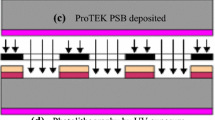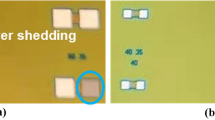Abstract
This works reports a packaged MEMS capacitive pressure sensor (CPS) employing single crystal 3C-SiC thin film as a diaphragm. The details of the design and fabrication steps involved bulk micromachining process. The 3C-SiC-on-Si wafer is back-etched the bulk Si to leave 3C-SC thin film by applied ProTEK PSB coating as a newly photosensitive layer. The ProTEK PSB is exposed into desired pattern of MEMS capacitive pressure sensor and the exposed pattern is developed by developer (ethylene lactate). The photosensitive can be stripped off with strong combination acid such as 2-(1-methoxy)propyl acetate, ethyl acetoacetate and photoacid generator which is attack the exposed ProTEK PSB while unexposed ProTEK PSB areas remain contact the alignment on the wafer surfaces. The prototypes of a MEMS capacitive pressure is packaged for high temperature up to 500 °C and characterized under static pressure of 5.0 MPa in a stainless steel chamber with direct capacitance measurement using LCR meter. The diaphragm of 3C-SiC thin film has the thicknesses of 1.0 µm and the size of 2.0 × 2.0 mm. At room temperature (27 °C), the sensitivity of the sensor is 0.00962 pF/MPa in the range of (1.0–5.0 MPa), with nonlinearity of 0.49 %. At 300 °C, the sensitivity is 0.0127 pF/MPa, and nonlinearity of 0.46 %. The sensitivity increased by 0.0031 pF/MPa, corresponding temperature coefficient of sensitivity is 0.058 %/ °C. At 500 °C, the maximum temperature coefficient of output change is 0.073 %/ °C being red at 5.0 MPa. The main impact of this work is the ability of the sensor to operate up to 500 °C, compare to the previous work using similar 3C-SiC diaphragm that can operates only 400 °C. The main impact of this work is the ability our CPS to operate up to 500 °C and pressure of 5 MPa to surpass the performance of previous work at lower temperature and pressure. In addition, this CPS has reliable stainless steel (SS) o-ring packaging with a direct assembly approach to reduce manufacturing cost and easy installation and maintenance environment.























Similar content being viewed by others
References
Chang S, Allen MG (2004) Capacitive pressure sensors with stainless steel diaphrgam and substrate. J Micromech Microeng 14:612–618
Chen L, Mehregany M (2008) A silicon capacitive pressure sensor for in-sylinder pressure measurement. Sens Actuator A 145–146:2–8
Chen Z, Du W, Zhao F (2013) Silicon carbide MEMS capacitive pressure sensor for harsh environment. ASTM 2013 Proceedings: Micro and nano-systems engineering and packaging, pp 1–5
Chuan CW, Bishnu PG, David JM, Carlos HM (2000) Contamination-intensive differential capacitive pressure sensor. J Micromechanical Syst 9(4):538–543
Gupta S, Pecholt B, Molian P (2010) Excimer laser ablation of single crystal 4H-SiC and 6H-SiC wafers. J Mater Sci 46:196–206
Hamzah AA, Majlis BY, Ahmad I (2004) Deflection analysis of epotaxially deposited polysilicon encapsulation for MEMS devices. Proc IEEE International Conferences on Semiconductor Electronics, pp 611–614
Jiang L, Cheung R (2009) A review of silicon carbide development in MEMS applications. Int J Comput Mater Sci Surf Eng 2:225–240
Kim JH, Park KT, Kim HC, Chun K (2009) Fabrication of pressure sensor for enhancing sensitivity using silicon nanowire. International Solid-State Sensors, Actuators and Microsystem Conference, pp 1936–1939
Marsi N, Majlis BY, Mohd-Yasin F, Hamzah AA (2014) The fabrication of back etching 3C-SiC-on-Si diaphragm employing KOH + IPA in MEMS capacitive pressure sensor. Microsyst Technol 20(8):1–11
Mehregany M (2008) Silicon carbide micro/nani system for demanding and harsh environment applications. Am Phys Soc 53(2)
Ned AA, Okijie RS, Kurtz AD (1998) 6H-SiC pressure sensor operation at 400 °C. IEEE Fourth International High Temperature Electronics Conference, pp 257–260
Padron I, Fiory AT, Ravindra NM (2011) Integrated optical and electronic pressure sensor. IEEE Sens J 11:343–350
Pengelly RS, Wood SM, Milligan JW, Sheppard ST, Pribble WL (2012) A review of GaN on SiC high electron-mobility power transistors and MMIC’s. IEEE Trans Microw Theory Tech 60(6):1764–1783
Shams QA, Kahng S, Mitchell M, Kuhn T (2002) A silicon carbide pressure sensor for harsh environment. AIP Conf Proc 608:353
Shields VB (1995) Application of silicon carbide for high temperature electonics and sensors. Jet Propuls Lab 1–9
Willander M, Friesel M, Wahad Q, Straumal B (2006) Silicon carbide and diamond for high temperature device applications. J Mater Sci 1–9
Yang J (2013) A harsh environment wireless pressure sensing solution utilizing high temperature electronics. Sensor 13(3):2719–2734
Zhang Y, Howver T, Gagoi N, Yazdi N (2011) A high-sensitive ultra-thin MEMS capacitive pressure sensor. IEEE International Conference Solid-State Sensors. Actuators and Microsystems, pp 538–543
Acknowledgments
The authors would like to thank the Institute Microengineering and Nanoelectronic (IMEN) of Universiti Kebangsaan Malaysia (UKM), Science-fund MOSTI for supporting this project under grant 03-01-02-SF0849 and Queensland Micro- and Nanotechnology Centre (QMNC) of Griffith University for providing the resources and facilities in part at the Queensland node of the Australian National Fabrication Facility, a company established under the National Collaborative Research Infrastructure Strategy to provide nano and micro-fabrication facilities for Australia’s researchers.
Author information
Authors and Affiliations
Corresponding author
Rights and permissions
About this article
Cite this article
Marsi, N., Majlis, B.Y., Hamzah, A.A. et al. Development of high temperature resistant of 500 °C employing silicon carbide (3C-SiC) based MEMS pressure sensor. Microsyst Technol 21, 319–330 (2015). https://doi.org/10.1007/s00542-014-2353-y
Received:
Accepted:
Published:
Issue Date:
DOI: https://doi.org/10.1007/s00542-014-2353-y




